Manifest Technology Blog
-- Site:
| Articles
| Galleries
| Resources
| DVI Tech
| About
| Site Map
|
Articles:
| PC Video
| Web Media
| DVD & CD
| Portable Media
| Digital Imaging
| Wireless Media
| Home Media
| Tech & Society
|
PC Video: |
PC Video Articles |
Video Software Gallery |
Video Editing Resources |
Digital Video Trends for 2006 --
High-Def to Handheld (1/2006)
by Douglas Dixon
HDV Is Here
High-Def DVD
WMV HD and MPEG-4
Portable Multi-Function Devices
Portable Media Players
Portable Storage
References
2006 promises to be an exciting and yet confusing year in digital video, as
the consumer electronics business pushes hard towards high-definition video --
at the same time that consumers are stampeding wildly to hand-held devices with
tiny screens. So which is it going to be -- big screen or little? Or maybe both
at the same time?
In recent history, we've benefited from the mass-market adoption of digital
technology, with the resulting dramatic price drops for hardware and software,
and widespread support for common formats even in $50 consumer applications.
We've made it though the transition to digital acquisition and editing with DV
camcorders, and the explosion of DVD as an effective delivery medium for
professionals and consumers alike.
The next year promises to bring the same kind of break-out excitement for
high-definition video, with sub-$1000 camcorders using the HDV format, and good
support in a broad range of editing applications. And to deliver this startling
crisp content, 2006 will finally see high-def DVD formats coming to market to
store and share this HD content, although complicated by competing incompatible
formats.
Yet at the same time that HD production finally is expanding beyond high-end
production to come into the reach of a broader market, low-res short-form video
is also taking off in the form of personal media players and mobile wireless
devices.
What a range of opportunities -- You can shoot real full-length HD
productions, delivered on wide-screen and even high-def DVD -- or go back to
small bite-size clips, targeted to people on the go. The creative possibilities,
and the ability to reach wide audiences through independent and Internet
distributions, have never been better.
The HDV high-definition video format has become a viable option over
the past year, starting with higher-end cameras, and then incorporated into
editing software (www.hdv-info.org). And
now HDV is becoming available in a wider range of even consumer equipment and
software. HDV is real high-def video, but stored on standard DV media. The video
is compressed using MPEG-2, like DVD, but in wide-screen 16:9 aspect ratio, and
at higher resolution than standard-definition 720 x 480 video.

As a result, HDV video is more aggressively compressed to fit up to 6X more
data into the same bandwidth used for DV (25 Mbps), and not much more than used
for MPEG-2 on DVD (typically 6 to 8 Mbps). HDV supports two basic formats: 720p
(1280 x 720, progressive), at approximately 19 Mbps, and 1080i (1440 x 1080,
interlaced), at approximately 25 Mbps.
You can import HDV video into a computer much like DV using a FireWire
interface. HDV is now supported on the Macintosh, from Apple iMove HD (www.apple.com/imovie)
to native editing in Apple Final Cut Pro 5 (www.apple.com/finalcutpro).
And it's available in new versions of pro and even consumer video software on
Windows like Vegas Movie Studio+DVD (www.sonymediasoftware.com).

 
However, editing HDV does require significantly more processing power to
handle the increase in resolution -- you'll probably want to upgrade your system
before doing intensive work. One way of easing the strain is to convert the
native HDV video to an intermediate format like CineForm (www.cineform.com)
or Windows Media Video. You then can edit more easily, and then export directly
from high-quality CineForm, or replace lower-quality intermediates with the
original HDV video for the final rendering. For example, Ulead Media Studio
Pro 8 has a Smart Proxy feature that automatically creates an intermediate
as you work (www.ulead.com/msp).
But then how can you share and display the final HD production? You can
transfer back to your HDV camcorder and display from there. And you can export
to SD formats -- you'll loose the higher resolution, but get great quality on DV
or for wide-screen DVD. Or you can display from a computer by exporting to WMV
HD format -- use 720p for good playback on a wide range of machines, or
higher-res 1080i on higher-end systems.
But where is the DVD format for HD content? There's been a lot of press about
this recently, as high-def DVD products will be shipping in 2006, using
blue-laser discs that can squeeze 3 - 5X more data on a disc. But the excitement
will be dampened by a nasty war between two competing formats.
In one camp is HD DVD, an incremental improvement championed by
Toshiba and NEC, and officially accepted by the DVD Forum consortium (www.hddvdprg.com).
HD DVD offers 15 GB of capacity per layer, or 30 GB for a dual-layer disc, and
then 45 GB for triple-layer.


In the other camp is Blu-ray Disc (BD), a more aggressive step forward
championed by Sony and Panasonic, with strong support from the consumer
electronics and computer industries (www.blu-raydisc.com).
Blu-ray offers 25 GB of capacity per layer, or 50 GB for a DL disc.
Expect HD DVD players to ship early in 2006, followed by recorders in the
second half of the year. Meanwhile, Blu-ray should come out of the gate with
both players and recorders, including PC drives and burners. But given the
confusion over conflicting formats, don't except these to be a quick success.
Interestingly, however, both HD DVD and Blu-ray have adopted the same two
next-generation video compression formats (which can be used for many other
purposes) -- the updated MPEG-4 AVC (also known as H.264, www.mpegif.org)
and Windows Media Video (WMV, being standardized as VC-1, www.microsoft.com/windows/windowsmedia).
These formats compress significantly better than MPEG-2 (requiring only around
1/3 to even 1/5 the space), and work well across the full range of applications
from highest-definition digital cinema to tiny-screen portable devices.
Using these formats, you can create your own content and then share clips on
a computer, stream over the Internet, download to handheld players, and even
burn to DVD to play on some set-top players, especially using the DivX
branded versions of MPEG-4 (www.divx.com).
The Apple QuickTime Player is a handy player for MPEG-4 files,
including the 3GPP variant used on many portable cameras and camera phones (www.apple.com/quicktime).
You can upgrade to QuickTime Player Pro to add the ability to edit and export
clips in these formats.


You also can edit these formats with new versions of today's video editing
tools, including Adobe Premiere Elements 2.0 (www.adobe.com/products/premiereel).
Or try Nero Recode to convert formats, again for use on some set-top
players, and even for downloading to the Sony PlayStation Portable (www.nero.com).


The Macromedia Flash Video format also is becoming popular beyond the
Web to portable devices (www.macromedia.com/devnet/mx/flash/video.html).
After all, why should you have to be tethered to a computer or television to
enjoy your video productions? Leave the big-screen display behind, and take your
video along with you -- today's portable devices now also serve as media
players, including game machines, mobile phones, and even digital cameras.
For example, you may have thought the Sony PlayStation Portable (PSP) was
a game machine, or even a movie player for watching features on the new UMD
(Universal Media Disc) small optical disc (www.us.playstation.com/psp.aspx).
But the PSP also serves as a nice media player for videos and photos, with its
bright 4.3 inch widescreen LCD, at 480 x 272 pixels.

But why carry a separate player at all, when mobile phones are evolving into
multi-function devices? Today's camera phones also can shoot and play MPEG-4
video clips, and share them over the cellular network though multimedia
messaging and e-mail. Multimedia phones also can play streaming wireless video
using services like Verizon Wireless V CAST (www.getvcast.com) and MobiTV
(www.mobitv.com). Even better, the addition
of flash memory cards to more phones means that you can download your own
content to bring along, using your phone as a portable player.


 V CAST NBC Mobile
V CAST NBC Mobile
Then there are full-fledged PDA phones, including the Palm Treo 650
with optional camera (www.palm.com), and Microsoft Pocket PC and Windows
Mobile smartphone devices with built-in Internet Explorer and Windows Media
Player (www.microsoft.com/windowsmobile),
like the Samsung SCH-i730 (www.samsungusa.com/wireless).
These are the best of both worlds -- the open PDA platform and local storage,
connected to the Internet though wireless cellular service. You then can run a
variety of applications to store and play your videos from storage cards, plus
access, download, and stream content from any Web site or Internet host.
While these multi-purpose devices allow you to bring everything along in one
unit, the best way to enjoy your media is to use a dedicated device that's
designed specifically for that purpose, especially with displays and navigation.
Of course, there's a tremendous variety of portable media player devices that
are focused on video and audio playback. You can trade off cost and capacity,
screen size and weight, and additional capabilities to find the best unit for
your needs.
To start with, for music and a relatively small amount of video, you can go
with a player using solid-state flash memory, which helps reduce the size and
cost, but limits the capacity to only up to a gigabyte or so.
For example, the ZVUE personal media player minimizes cost (down to
$99) by not including built-in memory and using larger AA batteries (www.zvue.com).
It has a 2.5", 160 x 240 screen, is relatively large at 4.33 x 2.91 x 1.1
in., and weighs 5 oz. without batteries. It's an inexpensive playback engine --
just add memory as needed.
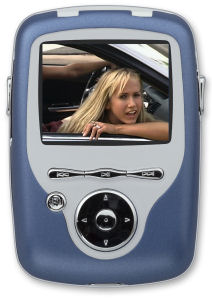
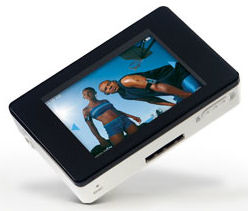
ZVUE personal media player - iriver U10
In comparison, the iriver U10 compacts the design of a flash-based
player around the 2.22", 320 x 240 screen, to a compact 2.7 x 1.8 x 0.6
in., and 2.50 oz. (www.iriveramerica.com).
It even dispenses with the controls -- you navigate just by pressing the edges
of the screen. And the U10 includes a FM tuner and voice recorder. It's
available with 512 MB for $199, and 1 GB for $249.
For more capacity, however, you'll need to step up from flash memory to a
player using hard-disk storage with the tiny 1" drives, offering tens of
gigabytes.
Of course there's the new Apple iPod video, available with 30 GB disk
for $299, and 60 GB for $399 (www.apple.com/ipod).
With a 2.5", 320 x 240 screen, the iPod uses a taller 4.1 x 2.4 x 0.43/0.55
in. design, at 4.8/5.5 oz. It plays MPEG-4 / H.264 video, up to 150 hours in 60
GB, and supports Apple FairPlay DRM (Digital Rights Management) to protect clips
purchased from the iTunes store.
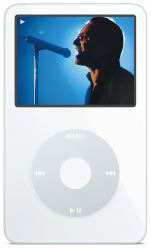 Apple iPod video
Apple iPod video
For a larger display to share with a group, the Creative Zen Vision
offers a 3.7", 640 x 480 screen, in a larger unit at 4.9 x 2.9 x 0.8 in.,
and 8.4 oz. (www.creative.com). Beyond MPEG-4, it also supports It also includes
FM radio, voice recording, speakers, A/V out, and a removable battery, and is
available with 30 GB for $399. The Vision plays MPEG-4, DivX, and WMV formats,
including Windows Media DRM for purchased content.
But why stop at just playback, and why require that TV shows be re-purchased
in portable formats? With DVR (Digital Video Recorder) software on your
computer, you can record TV shows and then download them to your portable
player. And, since many of these devices can record audio, why not video as
well?
For example, Archos has a broad line of portable video recorders (PVRs)
-- handheld players that also can record video (www.archos.com).
The small Archos Gmini 402 Camcorder has a 2.2 in., 220 x 176 screen,
and includes a 1.2 Mpixel camera for MPEG-4 capture, all in 5.64 oz, with 20 GB
storage for $399.
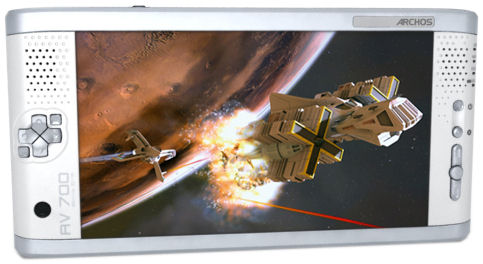 Archos AV700
Archos AV700
But for a wide-screen shared experience, the Archos AV700 Widescreen
Mobile DVR sports a 7", 480 x 234 widescreen display, in a larger 4.2 x
8.2 x 0.8 in., 20.8 oz. design. Even better, it has A/V input to record
directly, and even can schedule recordings though the included hub. The AV700 is
available with 40 GB for $599, and 100 GB for $799, for storing up to a million
photos, 55,000 songs, of 400 hours of full-screen MPEG-4, AVI, and WMV video.
This kind of availability of portable storage in flash cards and tiny hard
disks also means that you can bring along more than your digital media -- just
connect these devices to a computer as removable storage to drag and drop your
files to go. Of course, you don't necessarily want to be filling up your mobile
phone with documentation files, or your digital camera with spreadsheets, so it
also can make sense to use dedicated portable storage devices.
And there's that counter-trend toward high-def video, which means even
portable USB "thumb" drives with 1GB of flash memory really are not
going to have the kinds of capacity needed for dealing with longer-form full-res
video.
One answer is to step up to tiny portable hard drives that offer convenient
USB plug-and-play access in small form factors. For example, the lock-shaped Imation
Micro Hard Drive is available with 2 GB for $159 and 4 GB for $189 (www.imation.com),
and the rectangular Memorex Mega TravelDrive with 4 GB for $149 (www.memorex.com).

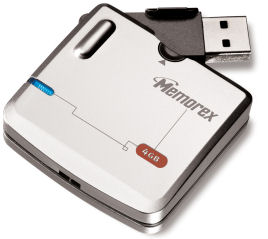
Imation
Micro Hard Drive -- Memorex Mega TravelDrive
Or here's the new credit-card LaCie Carte Orange with 4 GB for $99,
and 8 GB for $149 at 2.16 x 3.34 x 0.23 in. and 0.12 lbs. (www.lacie.com).
 LaCie Carte
Orange
LaCie Carte
Orange
However, the trade-off for the convenience of these tiny devices limits them
to 1" disks with single-digit gigabytes of capacity, and relatively slow
transfer rates of up to 9 MB/sec. By stepping up to larger but still palm-sized
designs you can still have highly portable storage, but with the kind of 40 to
80 GB capacities desirable for more intensive digital media work. These devices
are more like 5 x 3 x 1 inch in size, and weigh around 7 - 8 oz., but include
2.5" hard drives and multi-megabyte caches to offer throughput more around
25 MB/sec.
For example, the Western Digital Passport Portable is available with
40 GB for $149, 60 GB for $179, and 80 GB for $199 (www.wdc.com).
The shock-resistant Buffalo MiniStation HD Portable at 40 GB for $136,
and 80 GB $183 (buffalotech.com).
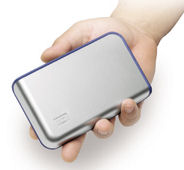
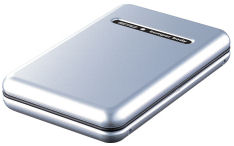
Western Digital Passport Portable -
Buffalo MiniStation HD Portable
And the slightly larger LaCie SAFE Mobile Hard Drive includes
fingerprint access security at 40 GB for $149, and 80 GB for $199.
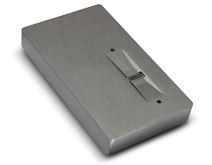 LaCie SAFE Mobile Hard Drive
LaCie SAFE Mobile Hard Drive
Home theatre -- or handheld? Integrated all-in-one for phone, data, and media
-- or separate devices? Big or small, or both at once? Whichever you like,
you'll be seeing a lot of options over the next year.
HDV Is Here
HDV Information
www.hdv-info.org
Apple - iMove HD
www.apple.com/imovie
Apple - Final Cut Pro
www.apple.com/finalcutpro
Sony Media Software - Vegas / Studio
www.sonymediasoftware.com
Ulead - Media Studio Pro
www.ulead.com/msp
CineForm
www.cineform.com
High-Def DVD
HD DVD
www.hddvdprg.com
Blu-ray Disc (BD)
www.blu-raydisc.com
WMV HD and MPEG-4
MPEG Industry Forum - MPEG-4 - AVC / H.264
www.mpegif.org
Microsoft - Windows Media Video (WMV)
www.microsoft.com/windows/windowsmedia
DivX
www.divx.com
Apple - QuickTime
www.apple.com/quicktime
www.apple.com/mpeg4
Adobe - Premiere Elements
www.adobe.com/products/premiereel
Nero - Recode
www.nero.com/us/Nero_Recode_2.html
Macromedia - Flash
www.macromedia.com
Portable Multi-Function Devices
Sony PlayStation Portable (PSP)
www.us.playstation.com/psp.aspx
Verizon Wireless - V CAST
www.getvcast.com
MobiTV / Idetic
www.mobitv.com
Palm - Treo 650
www.palm.com
Microsoft Windows Mobile
www.microsoft.com/windowsmobile
Samsung - SCH-i730
www.samsungusa.com/wireless
Portable Media Players
ZVUE personal media player
www.zvue.com
iriver - U10
www.iriveramerica.com
Apple - iPod
www.apple.com/ipod
Archos - Gmini 402, AV700
www.archos.com
Creative - Zen Vision
www.creative.com
Portable Storage
Imation Micro Hard Drive
www.imation.com
Memorex Mega TravelDrive
www.memorex.com
Western Digital - Passport Portable
www.wdc.com
Buffalo - MiniStation HD Portable
buffalotech.com
LaCie - Carte Orange, SAFE Mobile Hard Drive
www.lacie.com
Originally published in Camcorder & Computer
Video magazine, 22, 1, Jan. 2006.
|
